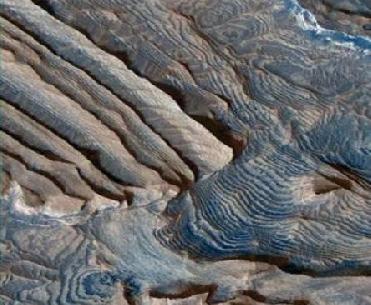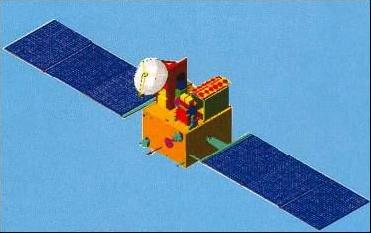
The periodic layering at Mars' Becquerel Crater. Image credit: NASA/JPL-Caltech/University of Arizona
WASHINGTON (BNS): NASA's Mars Reconnaissance Orbiter has captured in detail the climatic cycles that persisted for millions of years on ancient Mars. The orbiter�s telescopic camera captured the three-dimensional record of rhythmic patterns in thick stacks of sedimentary rock layers on the fiery Red Planet.
Kevin Lewis of the California Institute of Technology, Pasadena, said in a report published in last week�s issue of the journal Science that each layer has weathered into a stair step in the topography where material that is more resistant to erosion lies on top of material that is less resistant to erosion. Lewis is the lead author of a report on the periodic layering.
The researcher said some periodic change in the environment appears to have affected how resistant the rock-forming sediments became, perhaps from changes in what size of sand or silt particles were deposited by the wind, or from how the particles were cemented together after deposition.
NASA said researchers using the High Resolution Imaging Science Experiment camera reported the first measurement of a periodic signal in the rocks of Mars. "This pushes climate-cycle fingerprints much earlier in Mars' history than more recent rhythms seen in Martian ice layers. It also may rekindle debates about some patterns of rock layering on Earth�.
"Layers of similar thickness repeat dozens to hundreds of times in rocks exposed inside four craters in the Arabia Terra region of Mars. In one of the craters, Becquerel, bundles of a 10-layer pattern repeat at least 10 times, which could correspond to a known 10-to-one pattern of changes in the tilt of the planet's rotation axis.��
Alfred McEwen of the University of Arizona, Tucson, principal investigator for the camera and a co-author of the new report said it's easy to be fooled without knowing the topography and measuring the layers in three dimensions. "With the stereo information, it is clear there's a repeating pattern to these layers�.
Geologists commonly find �rhythms� or repeating patterns in sedimentary layers on Earth. Determining the source of the rhythms can be difficult, some result from annual or tidal cycles, or from episodic flooding that may not be periodic at all, but the role of longer-term astronomical cycles has been debated.
"One step in showing that astronomical cycles can leave their mark in sediments came from finding repeating five-layer sets in some terrestrial bedrock, matching a known five-to-one ratio of two cyclical variations in Earth's orbit," NASA said.
Describing the differences, Lewis said in addition to having rhythm of 10 beats to the bar instead of Earth's five-beat pattern, Mars has characteristics that make it a good laboratory for studying how astronomical cycles affect climate.
The tilt of Mars' axis varies much more than the axis of Earth, because Earth's relatively large moon provides a stabilising effect. And, at least for most of its history, Mars has lacked the oceans and thick atmosphere that, on Earth, modulate the effects of orbital variations and add their own cyclical patterns.
The 10-beat pattern of Mars' wobble lasts about 1.2 million years. If the 10-layer bundles in Becquerel crater are indeed signatures of that cycle, the 10 or more bundles stacked on each other record about 12 million years when environmental conditions affecting sedimentation were generally steady except for effects of the changing tilt, NASA said.
 Previous Article
Previous Article












The Indian Air Force, in its flight trials evaluation report submitted before the Defence Ministry l..
view articleAn insight into the Medium Multi-Role Combat Aircraft competition...
view articleSky enthusiasts can now spot the International Space Station (ISS) commanded by Indian-American astr..
view article